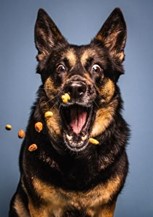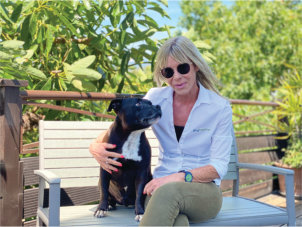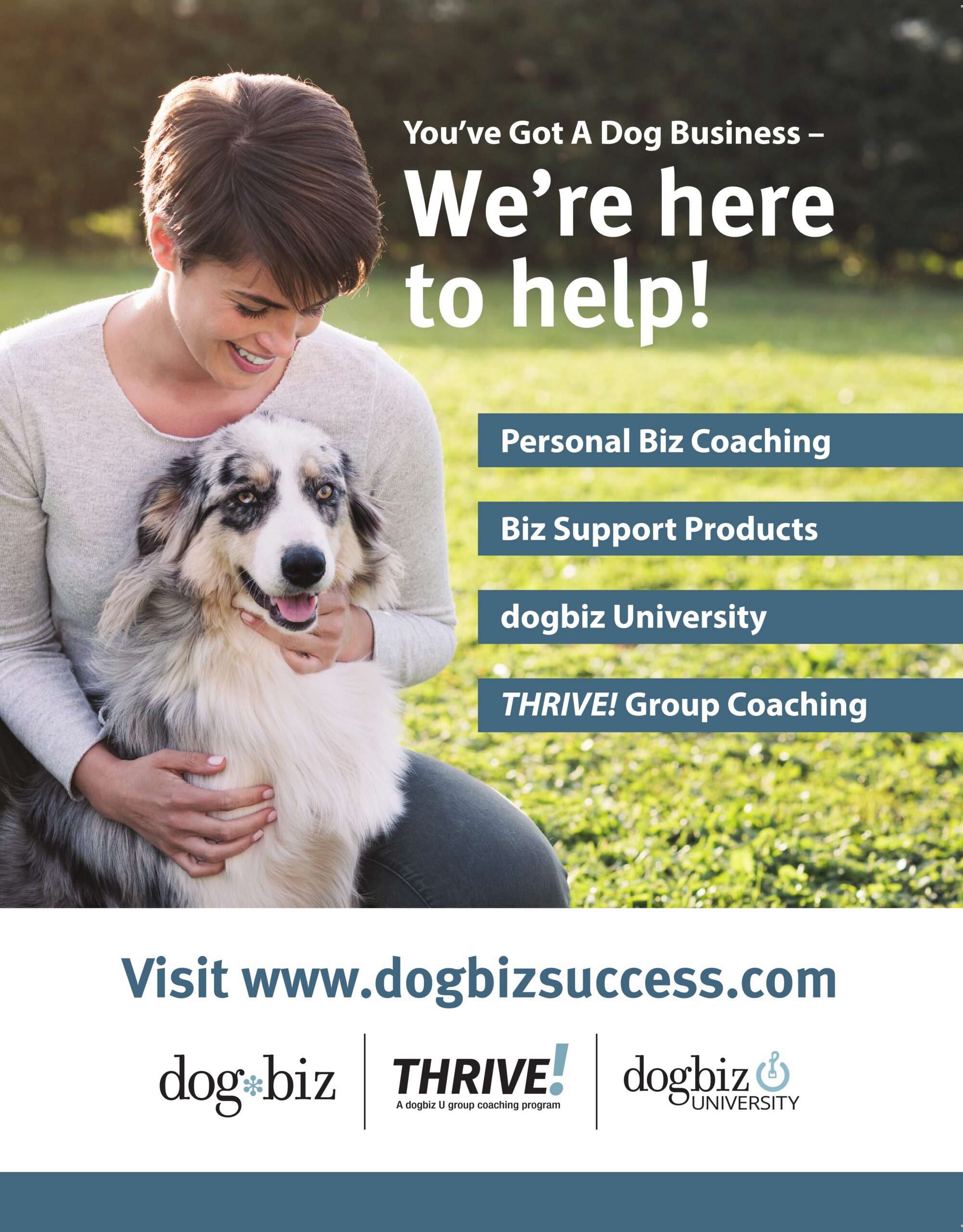Pets and Their People Blog
Dogs Are Food Motivated – They Need It for Survival
It’s our role to figure out what rewards work best in different situations!
At DogNostics, we hold a two-day Pet Care Professional Certification workshop where a question that we often hear is, “How can I train a dog who isn’t food motivated?” At The DogSmith, we also encounter clients who say that their dogs are not motivated by food, so we thought that a blog regarding this topic would be useful for pet guardians.
Is There a Health Concern?
There are many reasons why a dog may sometimes not wish to eat, but, as food is a primary reinforcer, that is, eating is essential for survival, ALL dogs are motivated by food.
If your dog is truly indifferent to food, please urgently contact your veterinarian. We also advise that you make an appointment with your veterinarian if your dog suddenly becomes very particular about what they will eat as this change could also be indicative of an underlying health concern. There are lots of conditions that could cause dogs to lose their appetite, for example, tooth pain, nausea, difficulty swallowing, pain on lowering the neck… Your veterinarian will be able to diagnose and treat, or rule out, any medical conditions.
Training with Food Rewards
Now, saying that all dogs are motivated by food does not mean that all dogs are going to be equally motivated, in all situations, all the time.
I have had dogs in my family who were absolute gluttons and would eat just about anything, anywhere, and at any time; but I have also had others who were much pickier and with whom I often used alternative reinforcers. Opting for something they love will increase the likelihood of them repeating a behavior. From different toys to heartfelt praise, from rides in the car to a game of tug, from life rewards to a round of fetch, there are so many options! However, when first training a new behavior, food is usually the best option as it allows for lots of quick repetitions of each training step. So, what can you do if your dog is not interested in eating the food during your training games?
Once you have ruled out any possible health concerns, you need to ask some questions that will help establish the possible reasons that your dog does not find food motivating during their training sessions.
Ten Key Questions
Let’s look at what we consider to be ten key questions and what you can do to address them:
1. Are you free-feeding?
Are you leaving your dog’s food down all the time? Dogs who are “free fed,” or given constant access to food, may be more difficult to motivate. When training, we do not want your dog to be hungry but neither do we want your dog to be so full that they have no desire to eat anything else. Peak performance will occur when your dog is motivated, but not if they are so hungry that they can’t think clearly!

like a game.
We always advise against withholding food as, not only is this unethical, but it could also be dangerous, even leading to hypoglycemia in small dogs.
We advise that when training, your dog is fed slightly less than the normal food ration. If for example, you have a class or session in the morning, I would recommend feeding half to three-quarters of their usual breakfast portion prior to training; that leaves a nice portion to use in your training session. If you are planning to train later in the day, your dog should be given all their breakfast, and then, depending on the amount of food that you use in your training session, you can deduct some from the evening meal.
Established mealtimes don’t just help when using food as positive reinforcement in your training sessions, not to mention when house-training puppies, it will also help make mealtimes a more pleasurable experience for your dog. Imagine the same plate of boring food was left out for you all day long…
On a side note, did you know that you can use food to provide additional mental and physical enrichment for your dog? Some of your dog’s food can, of course, be served in their bowl but you can also use some of their food in fun training sessions; serve some of their meals in interactive feeding toys; feed by scattering the food… There are so many ways to make food and your dog’s daily life more interesting!
2. Does your dog like the treats you are using?
Are you using a food your dog enjoys or are you using something that they find a little boring and tasteless? Training treats should be small, tasty, smelly, easy to chew, easy to swallow, and something your dog likes and is willing to work for! At home, in a non-distracting environment, and for easy-to-achieve behaviors, you can probably use some of your dog’s normal food. However, when out and about and for more difficult behaviors, you will need to offer something more enticing! How about some chicken, meatballs, deli meat, sausage, dried beef heart, cheese… Whatever your dog loves (and is safe to eat)!
3. Do you know your dog’s Hierarchy of Rewards?
Make sure that you have a variety of reinforcers on all levels of your dog’s Hierarchy of Rewards so that you have something to call upon of appropriate value in all situations. Make a list of all the different foods that your dog enjoys and then categorize them into different values. List all the lower value treats in one group, the medium value ones in another, and finally, the higher value ones. You now have a choice of ‘lower-value’ treats for use in your home and with easy behaviors in non-distracting environments; a choice of ‘medium-value’ treats that can be used with slightly more difficult behaviors or in slightly more challenging environments; and a selection of ‘high-value’ treats for all those more demanding situations and crucial behaviors such as name response or coming when called!
4. Do you realize that what your dog finds reinforcing in some situations may not have the same ‘value’ in other situations?
The ‘value’ of an individual reinforcer is not static and will change depending on such factors as:
- The behavior itself – Behaviors are easier or more difficult to reinforce as determined by the animal’s ability to do them and biological predisposition to behave in certain ways.
- The individual’s preferences
- Previous learning history
- The environment and motivation
There are variables affecting reinforcement and the value of each reinforcer at any given time, in different environments and with different individuals. For example, in the morning, at home, I love a cup of tea but in the afternoon, I am much more likely to fancy a cup of coffee! Varying the reinforcement that is offered will also help to overcome satiation – at some point, we have all eaten enough of that delicious cake but that doesn’t mean that we would say no to a piece of chocolate!
5. Have you overused the treats at the top of your dog’s Hierarchy of Rewards?
Bear in mind that if you use the ‘higher value’ reinforcers too frequently for easy behaviors in non-distracting environments, you could find that not only will your dog no longer be motivated to ‘work’ for lower value reinforcers, but also that you have decreased the value of those reinforcers that were previously at the top of the Hierarchy, making them less effective in more demanding situations or with more demanding behaviors.
6. Do you have your dog’s full attention, and do they have yours?
Are both you and your dog ready and eager to train? Are you fully engaged with each other? Are you lacking enthusiasm for the task at hand? Are you, or your dog, distracted by something else that is occurring in the environment?
Give your dog your full attention in an environment conducive to learning.
Even simple things, like making sure to turn your phone off so that you aren’t interrupted, will help. There is nothing worse than when, in the middle of a conversation with someone, they answer their phone and leave you hanging, making you feal irrelevant!
Are you training for too long? Your dog may lose interest in taking treats if the training sessions are too long. Lots of short sessions are better than one long one. If you have a longer training session scheduled, please make sure to give your dog lots of breaks; an opportunity to take a drink, to have a sniff around, a rest on a mat…
And make sure to always end the session on a positive note.
Training should always feel like a fun game which your dog will be eager to engage in again!
7. Are you expecting too much of your dog?
Your dog may be able to concentrate in your kitchen at home but that doesn’t mean that they will be able to do so in the middle of a busy town! Think about it… If I were to ask you to solve a mathematical problem at home in a quiet environment, you would be able to do so, provided I had previously taught you how to; but that doesn’t mean that you would be able to solve the same problem while in an amusement park! If I were to offer you a nice slice of cake while completing a simple crossword puzzle, I am sure that you would enjoy it; but would you enjoy that same slice of cake if I asked you to complete a difficult examination while surrounded by lots of people talking to you?
8. How are you delivering the food?
Did you know that the strategy you use to deliver the food treat to your dog can make it more (or less) motivating for your dog? There are lots of different methods to deliver the reinforcer and they will all affect its ‘value.’ Sometimes delivery to mouth is fine but other times, it can be much better to toss a treat for a dog to chase after, to place a treat on the floor, to run off and get the treat together, to throw the treat for your dog to catch, to flick the treat…
If delivering the treat to your dog’s mouth, how are you delivering it? We recommend presenting the food a couple of inches in front of your dog’s mouth, giving the option to reach forward a little to take it, rather than simply thrusting it into their mouth. You can present the food using your hand as a ‘plate’ for your dog to take the food from.
9. Are you inadvertently ‘devaluing’ the treat?
My students often ask me why their dogs respond more enthusiastically to me and seem willing to work much harder for me than for them, even when I am using the same reinforcer. The answer is multifaceted.
Motivation comes into play, and I become part of the reinforcement. It is no longer just a piece of chicken. It is a piece of chicken delivered by one of their favorite people; a piece of chicken delivered by someone they have limited access to – a little ‘deprivation’ increases my ‘value.’ Their dogs have access to them most of the time but only have access to me once or twice a week.
It is a piece of chicken soaked in smiles, happiness, and pride in their achievement.
It is a piece of chicken that engenders a positive emotional response. I always enthusiastically interact with the dog. I endeavor to celebrate even the smallest of achievements; whereas the guardians sometimes find it hard to see beyond what they believe their pets should really being doing and often deliver the same reinforcer while despondently saying things like, “Why won’t he do it like that for me?” The lack of enthusiasm deducts ‘value’ from the treat and from the training game – often so quickly and effectively that the dog simply stops ‘working.’
10. Is your dog feeling fearful, anxious, or stressed?
A dog’s willingness to eat can often be an indicator of their emotional state. If your dog is uncomfortable with a situation, they are unlikely to want to eat, their emotions will get in the way of their digestive system, and the ability to cognitively function will be impacted.
Dogs cannot learn if they do not feel safe.
Dogs who are overly aroused or excited will also not be interested in taking food. If you have a dog who is leaping around, straining on the leash, lunging, or barking, who is over the threshold of reactivity, you need to address the emotional response. Please contact a certified force-free training professional or behavior consultant.
About the Author

Louise Stapleton-Frappell – B.A. Hons. PCBC-A. PCT-A. CAP3. CTDI. CWRI. DN-FSG2. DN-CPCT2. FFCP, Professional Canine Behavior Consultant and Trainer – Accredited by the Pet Professional Accreditation Board , Co-Partner and Faculty Member of DogNostics Career Center and Board Member of The Pet Professional Guild.
Louise’s experience, her background as a teacher and her impressive pet industry credentials means she is uniquely qualified to share her skills and knowledge with both the public and pet industry professionals. The creator of the DogNostics ’ Dog Trainer Certification Program, Louise has presented at conferences internationally and has gained a reputation for expertly teaching and training humans and canines at her own establishment, The DogSmith of Estepona , in Southern Spain. Louise has published numerous articles on dog training and dog behavior and is also the published co-author of the following titles, A Lexicon of Practical Terms for Pet Trainers and Behavior Consultants, Pet Training and Behavior Consulting: A Model for Raising the Bar to Protect Professionals, and is a Pets and Their People contributor.
Additional Resources
A Kids’ Comprehensive Guide to Speaking dog! A fun, Interactive, educational resource to help the whole family understand canine communication.
But My Dog Isn’t Food-Motivated. Presented by Kathy Sdao
E-Book – Food That May be Toxic for Pets. Start reading today.
E-Workbook – 10 Steps to An Amazing Response to Name. Start reading now!
E-Workbook – How to Train a Reliable Come When Called. Start training today!
Find a professional – The Pet Professional Guild
Stress Busting Tips for Humans and Pets, Stapleton-Frappell (2021)
Teaching Self-Control in the Presence of Food – An Invaluable Resource for All Pet Dog Guardians, Trainers, and Pet Care Providers!

